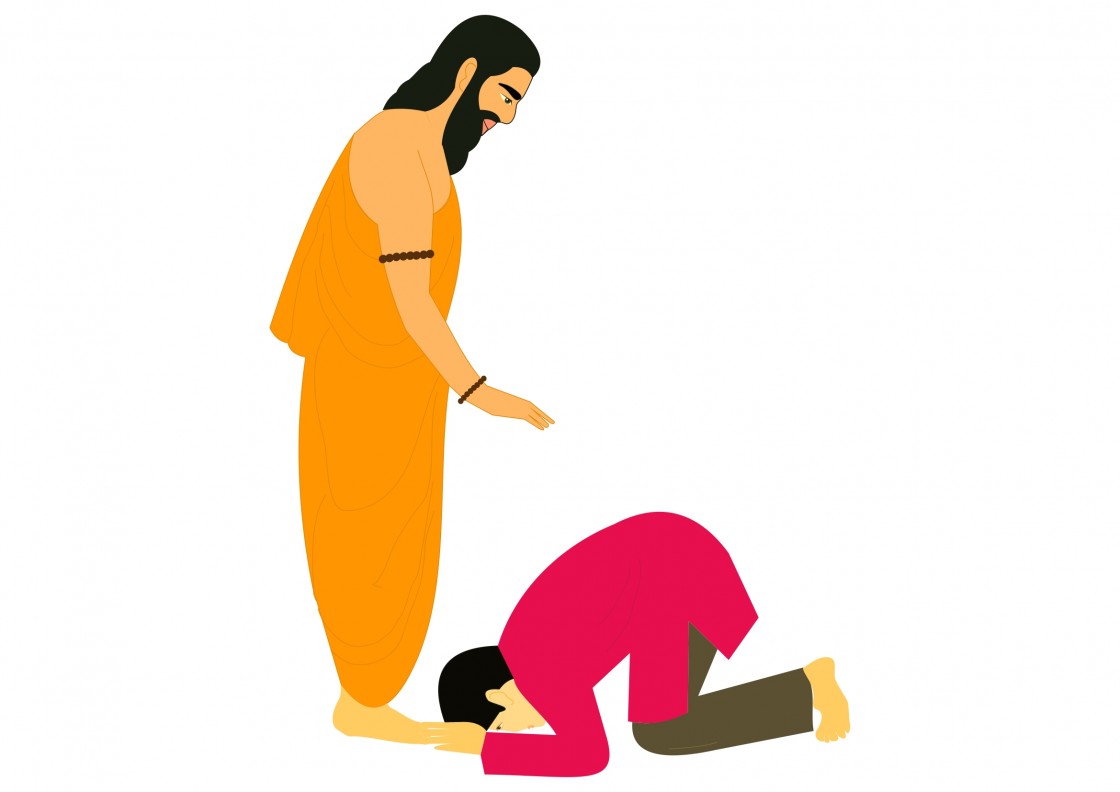Hinduism is full of rich traditions & culture. We all follow certain traditions without even knowing the reason behind it. We all follow it because that is what taught to us since our childhood. One such tradition is touching the feet (चरणस्पर्शः) of our elders. Every one of us touches the feet (चरण स्पर्शः) of the elders. But do you know why we touch the feet (चरणस्पर्शः) of our elders? Some people will say this is a way of showing respect to elders, while others argue that there are many other ways also for respecting the elders then why to choose this specific one? Is there any scientific reason behind it or is it just the myth being followed by generations?
Well!! There are both scientific as well as logical reasons connected to this tradition. Each & every rituals & traditions are connected to science in Hinduism, it's just that we don't want to see it that way because some so-called modern people doesn't want to accept & follow our rituals by calling it "typical old rituals & traditions".
In Hindu tradition, touching the feet (चरणस्पर्शः) is very common gesture that we offer to our elders. It is a sign of respect & it is adopted since Vedic period. Children are taught to touch the feet (चरणस्पर्शः) of elders; whether grandfather, grandmother, father or mother, etc. I still remember, since childhood at my home there is a tradition of touching the feet (चरणस्पर्शः) of our parents & grandparents early in the morning when we woke up & before going to the bed at night. Even our Rishis have observed four beneficial factors of touching the feet (चरणस्पर्शः), & they are - bestowing with strength, intellect, knowledge & fame.
The Scriptures suggests that, every time when you bow in front of your elders & touch their feet it makes you great & powerful. No matter how big & successful you become you will always need blessings. The Vedas suggests that, when you touch the feet of the elders you are acknowledging that, you are respecting their knowledge & you will be carrying forward their teachings to the next generation. It also suggests that, the process of learning is incomplete until you start it with touching the feet (चरणस्पर्शः) of the teacher & end it by touching the feet (चरणस्पर्शः) of the teacher. You must offer yourself to the teacher so that he can teach you all the knowledge that he has.
In an era of modernization also, touching the feet (चरणस्पर्शः) is the gesture of respect to the elders which most of the generations are still following. Elders give blessings (आशीर्वादः) while we touch the feet (चरणस्पर्शः) by saying long life, fortune, wisdom, etc.
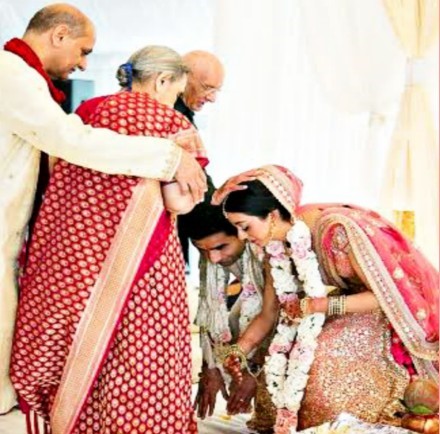
Occasions for touching feet in Hinduism -
Hindus touch the feet (चरणस्पर्शः) of the elders on various occasions in their daily life, such as:
• In the morning after taking bath & at night before going to bed. (though now a days many people don’t follow this but one should follow this).
• Before starting something new.
• On birthdays, Anniversaries
• On Life Rituals (Samskaras) like Garbhdhan (conciving a baby), Jatakarma (birth), Upanayan (starting schooling / sacred thread ceremony) Wedding, etc.
• During festive occasions.
• Before departing on a long journey.
• Before an exam or important interview/ meeting.
• When an elderly guest visits the house or when one visits an elderly person's house.
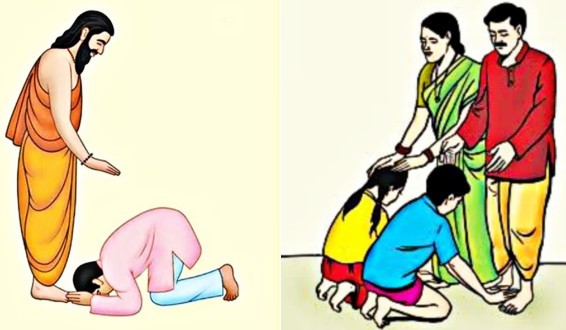
Whose feet one should touch (चरणस्पर्शः) ?
People touch the feet (चरणस्पर्शः) of their elder brothers/sisters, parents, husband, grandparents, teachers, spiritual gurus & other senior citizens. The feet of elders & such respectable people are touched because all through their life, they have acquired a lot of knowledge, experience & virtues, which prove to be extremely powerful & benefiting for the ones who show them respect & seek their blessings. But, on the occasion of Devi puja or such other rituals one also touches the feet (चरणस्पर्शः) of small girls & boys as our Scriptures suggests that small girls & boys aged between 1-10 are considered to be the Bhairav (God) & Bala (Goddess) as they are the most innocent & it is believed that they have God inside them. The tradition is that, during Navratri pujan people call few boys & girls to their house & offer food to Goddess & then to the boys & girls, later tilak is applied & gift is offered following by touching the feet (चरणस्पर्शः) of boys & girls (Bhairav & Bala).
Touching the feet of the kids (चरणस्पर्शः), is also a tradition in Hinduism because, kids are considered to be the form of God & this is the reason we touch the feet (चरणस्पर्शः) of the kids & this is why we can also greet everyone with Namaste. Many feels that we cannot greet kids with Namaste or we cannot touch the feet (चरणस्पर्शः) of the kids, which are totally wrong impressions. Scriptures itself suggests that, the one who have more knowledge or wisdom than us, even though that person is younger than us, still that person is considered to be respectable & thus, we can definitely touch the feet (चरणस्पर्शः) of that kid.
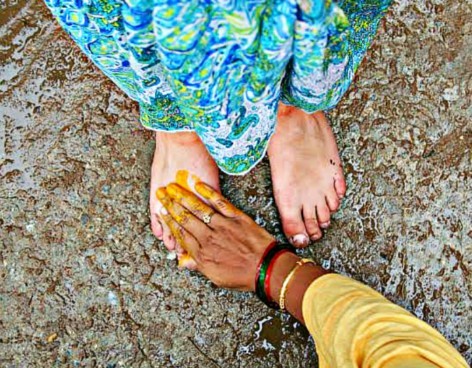
Correct way of touching the feet (चरणस्पर्शः) -
If taken from the ancient aspect, the best way to touch our elder’s feet is, to bend down in front of them, our back hunched & arms should be stretched forward. The hands must touch their feet & should be crossed in a way that right-hand touches the right foot & the left-hand touches the left foot.
According to science, a human body contains negative & positive currents of electricity. The left side of the human body carries negative current & the right side of the body has positive current. Therefore, two halves together complete a circuit built of positive or negative. And so, it is suggested that while touching the feet, we should cross the hands. So, the positive current in both flows in a uniformed circuit & same for negative current. Thus, both the currents formes a well-unified circuit. The result is highly positive energy flowing from their feet transferring to the other person with a lot of good will & healing energy. Also, the person whose feet are touched usually stretches his or her hands to touch the upper head of the person with a gesture of offering blessings (आशीर्वादः). This connection forms yet another circuit again transferring energy in the form of blessings.
So, don’t forget to follow this beautiful tradition of Hinduism. Bow yourself in front of the elders & those who are noble in their attitude. The thoughts, vibrations & the words emerging from them are so powerful that they will benefit you immensely.
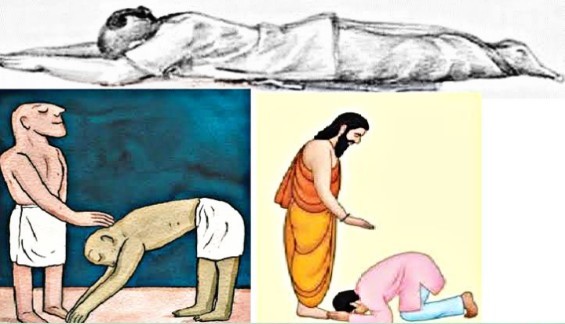
Different types of touching the feet (चरणस्पर्शः) -
As per Indian scholars, there are three ways of touching the feet (चरणस्पर्शः). The first one is the basic way of bending forward & touching the feet, this one is generally practiced to every elderly person. The second is to sit on the knees & then bend forward & touch the feet (चरणस्पर्शः) of the other person & this is known as Panchanga Pranam (पञ्चाङ्ग प्रणाम्) Panchanga Pranam (पञ्चाङ्ग प्रणाम्) is generally practiced while touching the feet of the teacher or spiritual gurus or saintly person & women practice this to bow down to the Deities. The third & the last one is to lying down on the stomach, with the forehead touching the ground & stretching the hands forward, this is also known as Sashtanga Dandvat Pranam (साष्टाङ्ग दण्डवत् प्रणाम्). It is generally practiced by men devotees in Hindu temples & during puja rituals or to the spiritual guru or saintly person.
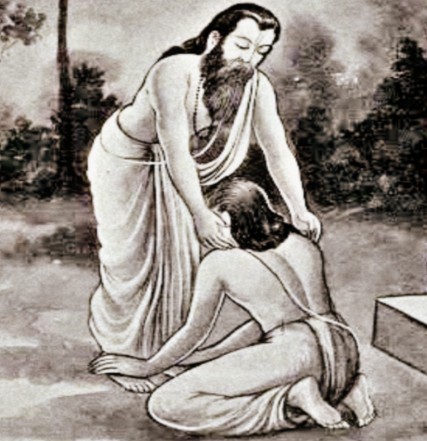
Significance of touching the feet (चरणस्पर्शः) in Hindu tradition -
The practice of touching the feet (चरणस्पर्शः) of elders was adopted in Hinduism during the Vedic period. According to the Hindu tradition, when you touch the feet (चरणस्पर्शः) of an elderly person, you are in turn blessed with knowledge, intellect, strength & fame. There is a hidden meaning to this entire act that, those who are elder to you have obviously walked on this earth longer than you, have lived longer than you & thus have gathered a lot of wisdom & experience. So, if you touch all the dust on their feet that they’ve collected walking along their way, your life & future will be highly benefited.
Moreover, touching the feet (चरणस्पर्शः) of elderly person is a sign of respect for their age, maturity, nobility, knowledge, wisdom & divinity of that person. It symbolizes our recognition of their selfless love for us & the sacrifices that they have made for our welfare. It is ahumble way of acknowledging the greatness of that elderly person. This tradition reflects the strong family ties which have been one of Hindu’s enduring strengths.
By touching the feet (चरणस्पर्शः) of the elders we seek good thoughts & create positive vibrations. Good wishes springing from a heart of love, divinity & nobility have tremendous strength. When we touch the feet (चरणस्पर्शः) with modesty & respect, we invoke the good wishes & blessings (आशीर्वादः) of elders which flow in the form of positive energy to shield us from negativity. That is why this posture, whether it is in the standing or other position, it enables the entire body to receive the positive energy.
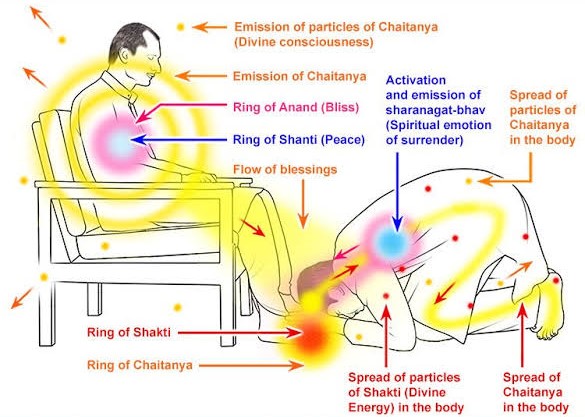
Scientific benefits of touching the feet (चरणस्पर्शः) of the elders -
1. By touching the feet (चरणस्पर्शः) of elders, people are blessed with strength, intellect, knowledge & fame.
2. The nerves in the human body, starting from our brain, spread all over our body & end at our fingertips & toes, by touching the feet (चरणस्पर्शः) of the elders these nerves get activated & absorbs the positive vibrations.
3. We all know that nerves coming out of the brain are present all over the body. These nerves end at the fingertips of hands & feet. So, when you touch your fingertips to the opposite feet of the elder, the energies of two bodies are connected. Fingers & palms become the receiver of energy & feet of another person as the provider of energy.
4. When you touch the feet (चरणस्पर्शः) of the elder keeping aside your ego, then the elder accepts your reduced ego & because of your surrendering act, they feel bliss & their heart emits positive vibrations or thoughts & energy.
5. This also helps in reducing the ego of the person because of which it makes the person humble & kind.
6. One kind of cosmic energy also released while touching the feet (चरणस्पर्शः) that connect each other’s mind & heart. So, when you touch the feet (चरणस्पर्शः) of a good soul, you will choose the right path or you will get the right direction in your life.
7. Touching the feet (चरणस्पर्शः) of the elders is a form of yoga as well, while bending forward to touch feet, your back & waist are stretched which is helpful in reducing back pain, arm pain, etc.
8. Bowing down & touching the feet (चरणस्पर्शः) increases blood circulation which is good for health.
9. When you sit on your knees & then touch the feet (चरणस्पर्शः) of an elder, your knees are bent & all of the joints in your body are stretched, which relieves all kinds of joint pain.
10. While engaging in Sashtanga Danvat Pranam (साष्टाङ्ग दण्डवत् प्रणाम्), your entire body stretches & cures the body pain.
11. When the elder accepts this respect, their heart becomes filled with good thoughts & positive energy, which they bestow through their hands (आशीर्वादः - act of giving blessings) & feet.
Thus, there are lots of benefits in touching the feet (चरणस्पर्शः) of the elders as it gives a kind of respect & dedication which arouse automatically & helps in suppressing the egoistic nature of a person. There are lots of scientific benefits & on the other hand it is also a good exercise which is helpfull for boosting health. The custom of touching the feet (चरणस्पर्शः) should be practiced with whole heartedly.
आषाढः शुक्लपक्षे १, २०७६
